Montana, with its vast landscapes and diverse habitats, is a haven for bird enthusiasts. A special delight for birdwatchers is the plethora of blue-colored birds found across the state. This guide provides a comprehensive look at the 12 Blue Birds found in Montana, complete with a Free Photo Guide to help you identify and appreciate the subtle differences and unique characteristics of each species.
Whether you are a seasoned birdwatcher or a beginner eager to learn, this guide is the perfect companion for your birdwatching journey in Montana.
Blue Birds Found In Montana
The diversity of habitats in Montana, ranging from the alpine regions of the Rocky Mountains to the prairies of the Great Plains and the dense coniferous forests, creates a unique environment that supports a wide variety of bird species.
The state’s diverse geography provides a range of nesting and feeding opportunities, making it a favorable location for many different types of birds, including a variety of blue birds.
Eastern Bluebird
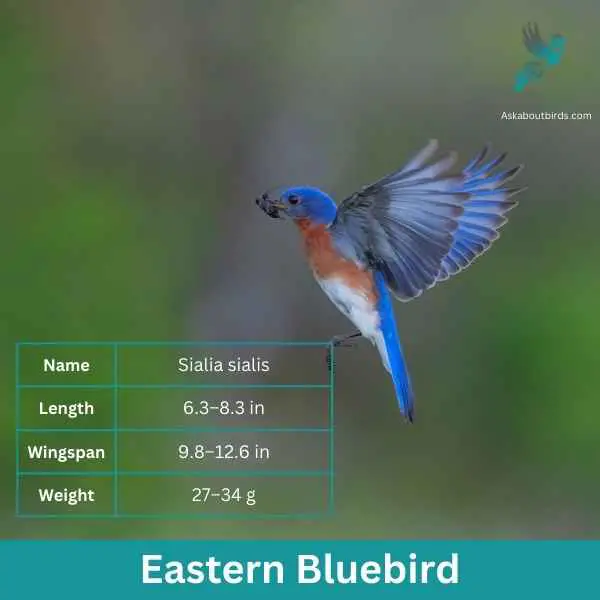
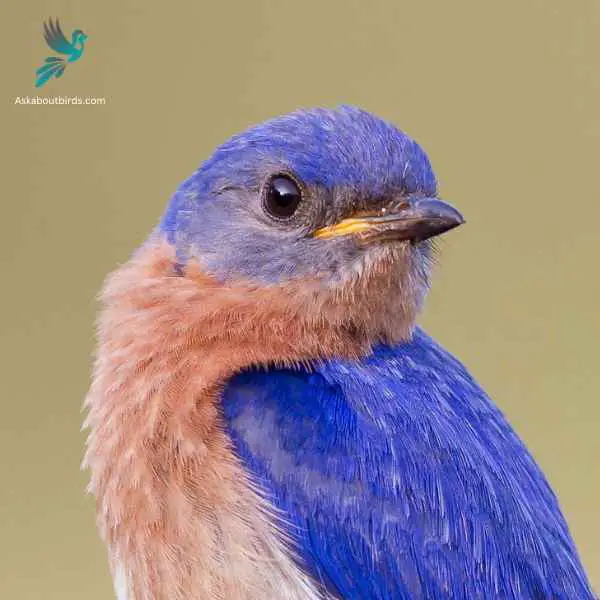
| Feature | Measurement |
|---|---|
| Scientific Name | Sialia sialis |
| Length | 6.3–8.3 in |
| Wingspan | 9.8–12.6 in |
| Weight | 27–34 g |
The Eastern Bluebird (Sialia sialis) is a small thrush found in open woodlands, farmlands, and orchards, and is recognized for its vibrant blue and red coloration. Male Eastern Bluebirds are dazzling with bright blue upperparts and a rusty or brick-red throat and breast, while females, though less colorful, still offer a similar pattern. The bird is native to North America and is commonly seen east of the Rockies, from Canada to the Gulf States and southeastern Arizona to Nicaragua.
Eastern Bluebirds feed on insects, wild fruit and berries. They have a gentle nature and are often seen perched alone or in small groups in the open, scanning the ground for prey. They are cavity nesters and will use old woodpecker holes or birdhouses if they are the right size.
Western Bluebird
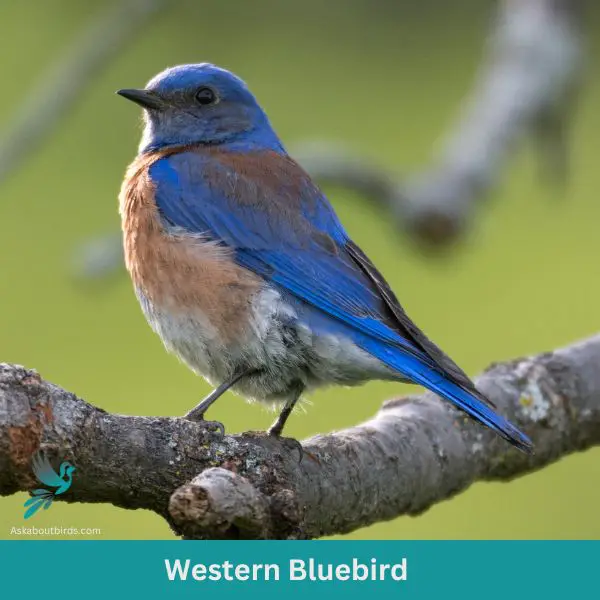
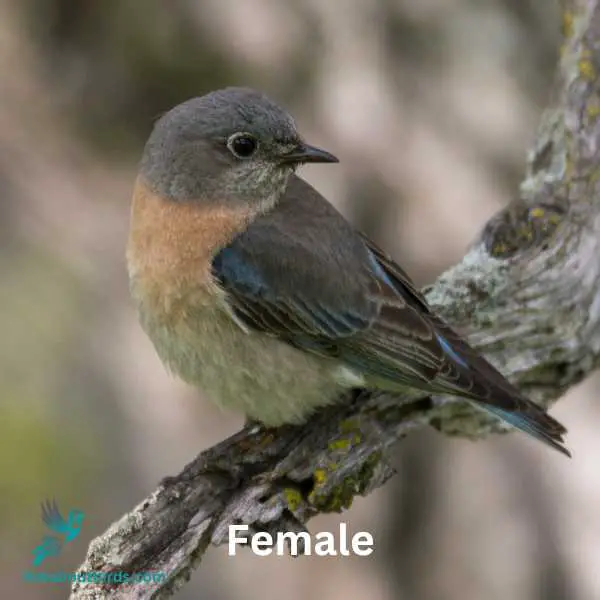
| Trait | Western Bluebird |
|---|---|
| Scientific Name | Sialia mexicana |
| Length | 5.5-7 inches |
| Wingspan | 11-13 inches |
| Weight | 0.8-1.1 ounces |
The Western Bluebird is a charismatic bird, appreciated for its vivid coloring and melodious song, commonly observed in open woodlands and meadows of the West.
Appearance: The male Western Bluebird sports a dark blue head, throat, wings, and tail with an orange breast and sides, transitioning into a grayish belly. Females are more muted, displaying grayish-blue wings and tail with a more subdued orange wash on the chest.
Diet: Western Bluebirds predominantly feed on insects, complemented by berries and fruits when available. They hunt by perching and then diving to the ground to capture their prey, and they’re also known to catch insects in mid-air.
Reproduction: These birds often utilize natural tree cavities or nest boxes for breeding. The female builds a loose nest inside and lays a clutch of 4-6 pale blue eggs.
Mountain Bluebird
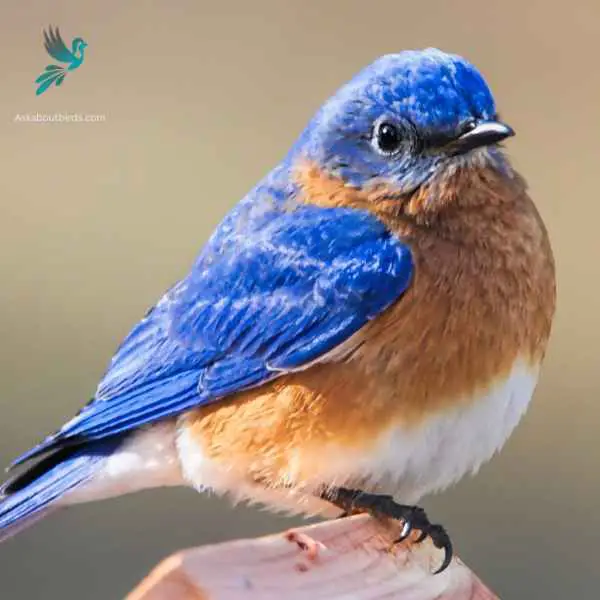
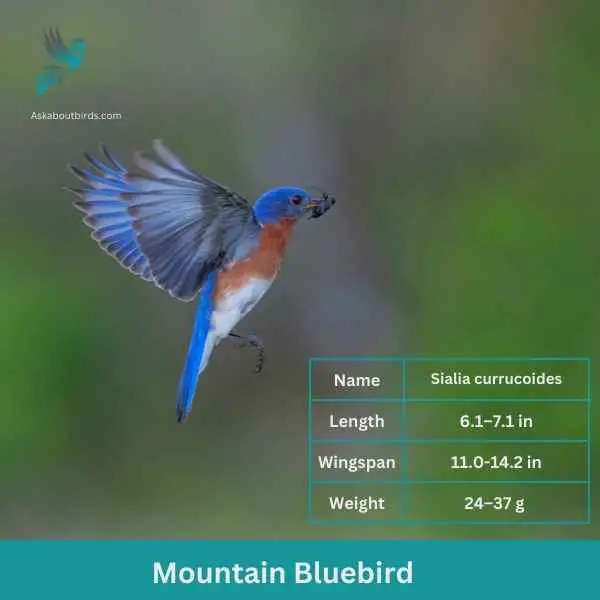
| Feature | Measurement |
|---|---|
| Scientific Name | Sialia currucoides |
| Length | 6.1–7.1 in |
| Wingspan | 11.0-14.2 in |
| Weight | 24–37 g |
The Mountain Bluebird is a small bird found in open grasslands and rocky mountains of North America. It is known for its stunning blue plumage, which is particularly vibrant in males. Females, on the other hand, have a more subdued blue coloration with hints of gray. These birds have slender bodies and a slightly curved bill, adapted for catching insects on the wing.
Mountain Bluebirds are insectivores, feeding primarily on insects such as beetles, grasshoppers, and spiders. They are skilled aerial hunters, capable of capturing their prey in mid-flight. During breeding season, these birds build their nests in tree cavities or man-made nest boxes, where females lay a clutch of eggs. The male bluebird actively participates in nest-building and provides food for the female during incubation.
Indigo Bunting


| Feature | Measurement |
|---|---|
| Scientific Name | Passerina cyanea |
| Length | 4.5–5.1 in |
| Wingspan | 7.1–9.1 in |
| Weight | 11.2–21.4 g |
The Indigo Bunting is a strikingly vibrant songbird, often hailed for its brilliant blue plumage and melodic song that graces woodlands and meadows during the warmer months.
Appearance: Males are renowned for their bright indigo blue feathers, which can appear darker in certain lights. Females and juveniles, on the other hand, are brown with subtle hints of blue on their wings and tail. The species lacks the vibrant streaking or spotting commonly found in many other songbirds.
Diet: Indigo Buntings primarily subsist on seeds, especially during non-breeding seasons. During the breeding season, they also consume a variety of insects such as beetles, caterpillars, and spiders, providing essential protein for their growing chicks.
Reproduction: Indigo Buntings build their nests close to the ground in shrubs or low tree branches. These nests, crafted meticulously with grasses and other plant materials, cradle clutches of typically 3 to 4 eggs. After hatching, the young are fed by both parents until they’re ready to fledge.
Lazuli Bunting
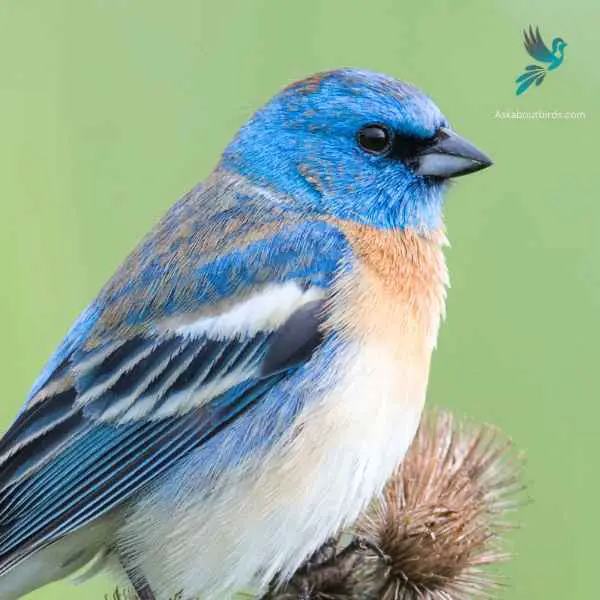

| Feature | Measurement |
|---|---|
| Scientific Name | Passerina amoena |
| Length | 5.1-5.9 in |
| Wingspan | 8.7 in |
| Weight | 13-18 g |
The Lazuli Bunting is a vibrant songbird recognized for its brilliant colors and melodious song, frequently seen in brushy areas and woodlands during the summer months.
Appearance: The male boasts a dazzling bright blue head and back, offset by a white belly and rust-orange breast. Females and immature birds present a more muted brownish hue overall, with a hint of blue on the wings and tail.
Diet: Lazuli Buntings primarily feed on seeds, but during the breeding season, they’ll also consume insects. Their strong, conical beaks are perfectly adapted for seed-cracking.
Reproduction: The female Lazuli Bunting constructs a cup-shaped nest using grasses, twigs, and other fine materials, often placing it in a shrub or low tree. She typically lays a clutch of 3-4 pale blue or white eggs.
Blue Jay

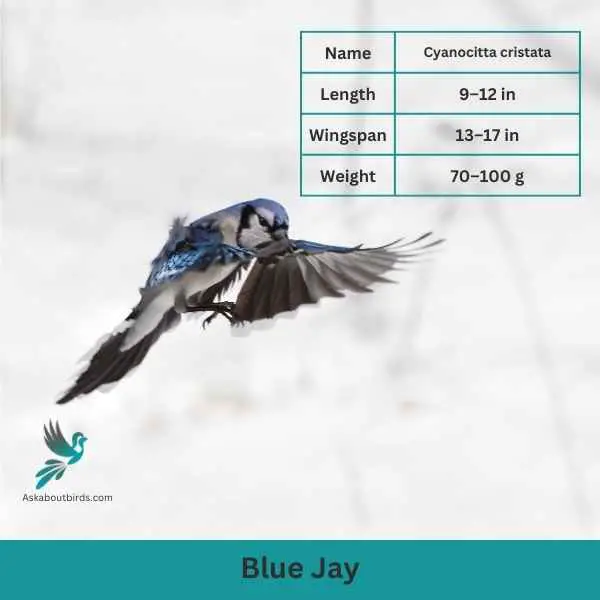
| Feature | Measurement |
|---|---|
| Scientific Name | Cyanocitta cristata |
| Length | 9–12 in |
| Wingspan | 13–17 in |
| Weight | 70–100 g |
The Blue Jay is a vibrant and easily recognized bird, known for its intelligence, distinctive calls, and bold behavior, commonly found throughout the eastern and central United States.
Appearance: The Blue Jay sports a striking blue upper body with white and black markings. Its face has a pronounced white patch with a black necklace that runs across the throat and around the head. The bird also features a pronounced blue crest, which can be raised or lowered, and its wings and tail are brightly colored with black bars and white tips.
Diet: Blue Jays are omnivores. Their diet consists primarily of seeds, nuts, especially acorns, fruits, and small insects. They’ve also been known to eat eggs or nestlings of other birds occasionally. Blue Jays often store food items in caches to eat later.
Reproduction: Blue Jays are monogamous birds that form long-lasting pair bonds. They typically build their nests in trees or large shrubs, constructing them from twigs, grass, and sometimes using mud as a binder. The female lays a clutch of 3 to 6 eggs, which are pale blue or sometimes white with brown speckles.
Steller’s Jay
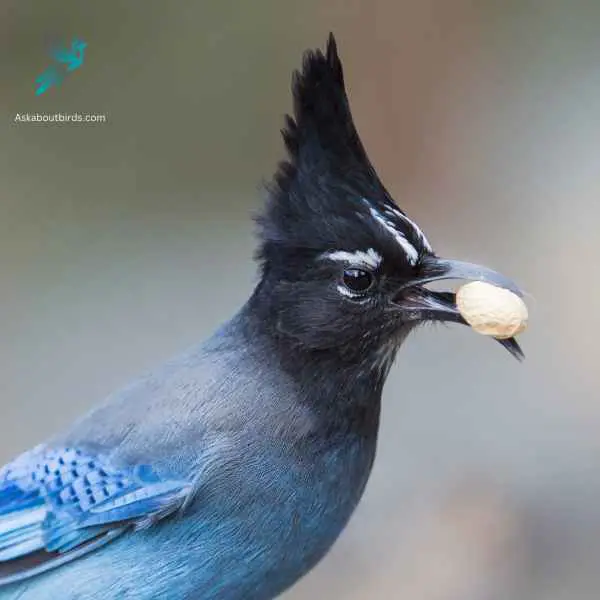

| Feature | Measurement |
|---|---|
| Scientific Name | Cyanocitta stelleri |
| Length | 12–13 in |
| Wingspan | 45 to 48 cm |
| Weight | 45 to 48 cm |
The Steller’s Jay is a charismatic and easily recognizable bird found mainly in the coniferous forests of the western North America, known for its bold behavior and loud, varied calls.
Appearance: The Steller’s Jay has a striking color contrast with a deep blue body and wings and a blackish head and upper body. One of its most distinguishing features is the tall, dark crest on its head, which can be raised or lowered depending on the bird’s mood. Its eyes are dark and its beak is strong and black.
Diet: The Steller’s Jay is omnivorous. It feeds on a wide range of items, from seeds, nuts, and berries to insects and small animals. It’s also known to raid campsites and picnics, often scavenging for human food.
Reproduction: Steller’s Jays form monogamous pairs that often remain together for several years. They typically build their nests in coniferous trees, made from twigs, moss, and other plant materials. The female lays a clutch of 2 to 6 eggs, which are usually pale green or blue with brown spots.
Blue Grosbeak
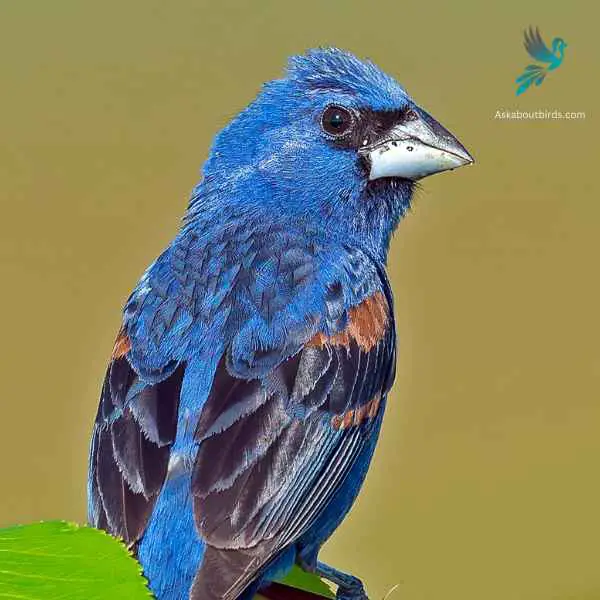

| Feature | Measurement |
|---|---|
| Scientific Name | Passerina caerulea |
| Length | 5.5 to 7.5 in |
| Wingspan | 10 to 11 in |
| Weight | 26 to 31.5 g |
The Blue Grosbeak is a medium-sized songbird found in North and Central America. The male Blue Grosbeak displays stunning plumage with deep blue feathers on its body and head, while the female has more subdued brownish tones. Both sexes have a thick, conical bill, which gives them their name “grosbeak,” meaning large beak.
These birds prefer open habitats such as grasslands, brushy areas, and woodland edges. Blue Grosbeaks are known for their melodious songs, which consist of a series of rich and varied notes. They primarily feed on seeds and insects, using their strong beaks to crack open seeds and forage on the ground or in low vegetation.
Tree Swallow
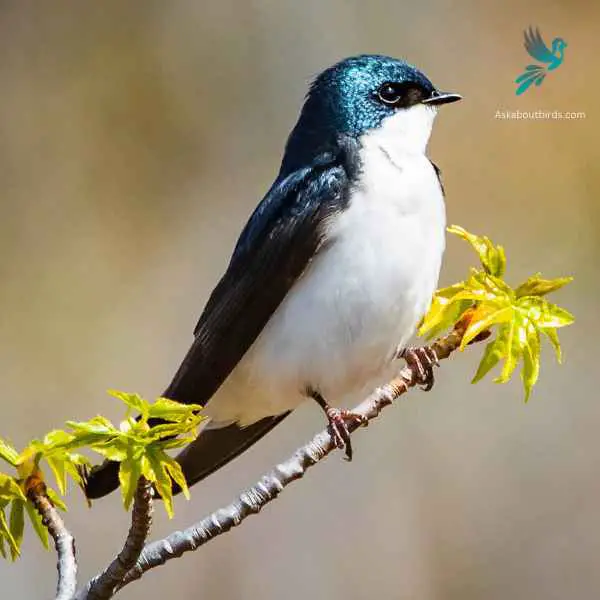
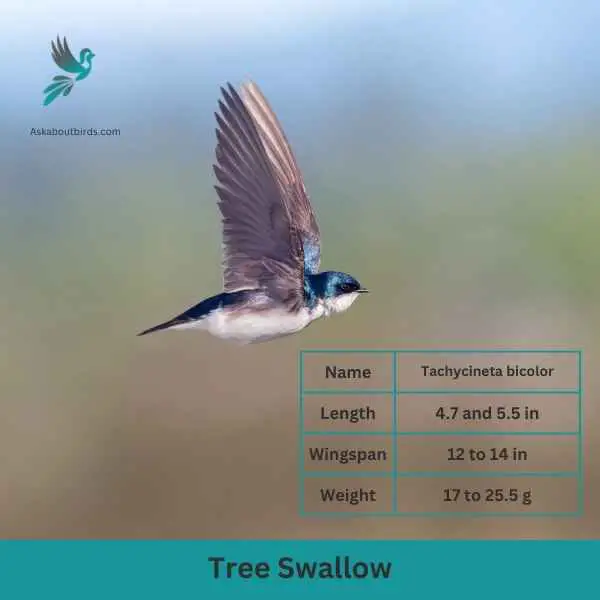
| Feature | Measurement |
|---|---|
| Scientific Name | Tachycineta bicolor |
| Length | 4.7 and 5.5 in |
| Wingspan | 12 to 14 in |
| Weight | 17 to 25.5 g |
The Tree Swallow is a graceful and agile bird, best recognized for its iridescent blue-green upperparts and sweeping flight patterns over open fields and water.
Appearance: The Tree Swallow is sleek with a streamlined body. The upperparts shine with a blue-green iridescence while the underparts are white. They possess long, pointed wings and a slightly forked tail, aiding in their agile flight.
Diet: Tree Swallows primarily feed on flying insects, skillfully catching them mid-air. During colder months when insects are scarce, they can switch to a diet of berries, particularly those of the bayberry, which other birds might find hard to digest.
Reproduction: Tree Swallows are cavity-nesters, typically choosing natural holes in trees or using bird boxes. They line their nests with feathers, creating a soft environment for the eggs. The female will lay a clutch of 4 to 7 white eggs.
Violet-green Swallow
Scientific Name: Tachycineta thalassina
Length: 4.7-5.1 in (12-13 cm)
Wingspan: 9.8-11.4 in (25-29 cm)
Weight: 0.4-0.6 oz (11-17 g)
The Violet-green Swallow is a small, agile bird known for its vibrant coloring and acrobatic flight skills.
Appearance: The male Violet-green Swallow has a bright, iridescent green back and head, and violet-blue wings and tail. The face, sides of the rump, and underparts are white. The female has a similar but duller coloration, with less iridescence on the back and head, and often a brownish tinge on the face and flanks.
Diet: Violet-green Swallows primarily feed on flying insects, which they catch in the air during their acrobatic flights. Their diet includes a wide variety of insects such as flies, wasps, ants, and beetles.
Reproduction: Violet-green Swallows typically nest in tree cavities, building nests, or cliff crevices. They often use old woodpecker holes or nest boxes provided by humans. The female lays a clutch of 4 to 6 white eggs, and both parents take turns incubating the eggs and feeding the chicks once they hatch.
Belted Kingfisher

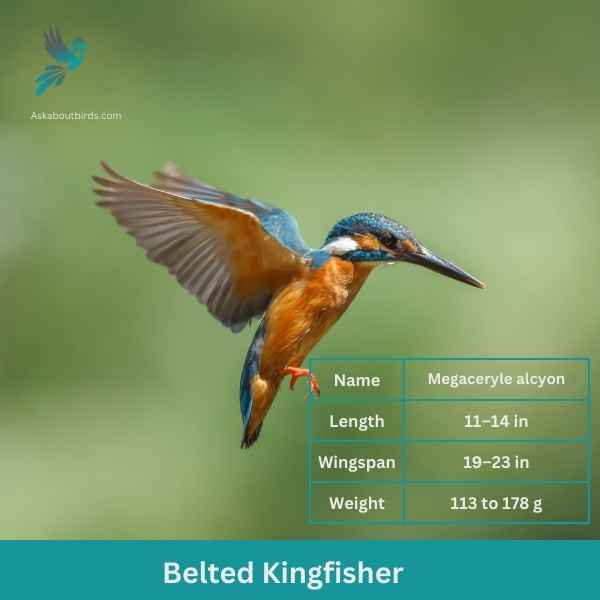
| Feature | Measurement |
|---|---|
| Scientific Name | Megaceryle alcyon |
| Length | 11–14 in |
| Wingspan | 19–23 in |
| Weight | 113 to 178 g |
The Belted Kingfisher is a distinctive and easily recognizable bird, frequently observed near water bodies, where it can be seen diving headfirst to catch prey.
Appearance: Sporting a prominent crest, the Belted Kingfisher has a slate blue-gray upper body and white underparts. Males possess a single blue band across their white chests, while females have an additional rufous band, making them one of the few bird species where females are more brightly colored than males. Their bill is long, sharp, and dagger-like.
Diet: As expert fishers, Belted Kingfishers mainly prey on small fish, but they’ll also consume crustaceans, insects, and amphibians. They’re known for their hunting tactic of hovering over water, spotting their prey, and then diving swiftly to snatch it.
Reproduction: Belted Kingfishers nest in burrows which they excavate in sandy or earthen banks, usually adjacent to water. The tunnel can be anywhere from 3 to 6 feet long, ending in a chamber. Within this chamber, the female lays a clutch of 5 to 8 white eggs.
Common Grackle
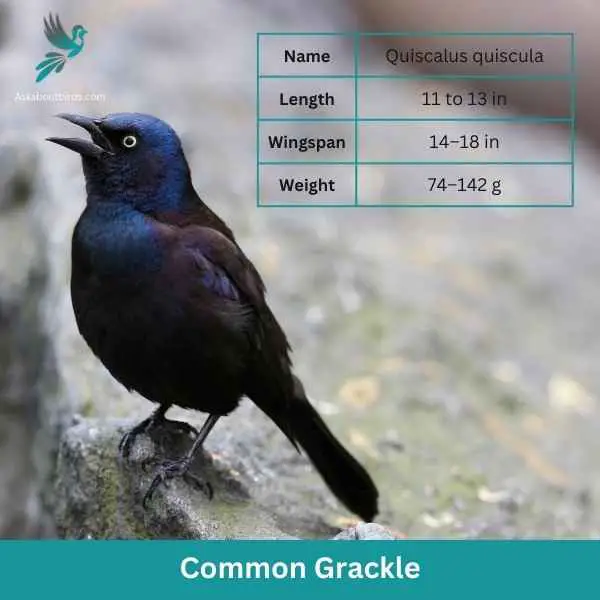

| Feature | Measurement |
|---|---|
| Scientific Name | Quiscalus quiscula |
| Length | 11 to 13 in |
| Wingspan | 14–18 in |
| Weight | 74–142 g |
The Common Grackle is a conspicuous bird found across much of North America, recognized for its glossy-black plumage, long tail, and piercing yellow eyes. Its vocalizations are varied and include a range of harsh, grating calls.
Appearance: The Common Grackle has a sleek black body with a glossy-iridescent sheen that can appear purple, green, or blue in certain lights. Its tail is long and keel-shaped. While both males and females have similar coloration, males are noticeably larger and shinier than females.
Diet: Common Grackles are omnivores. They primarily consume seeds, berries, and insects. However, they are also known to eat small fish, amphibians, and other birds’ eggs, especially when foraging on the ground or in shallow water.
Reproduction: Common Grackles breed in open and semi-open areas. The female typically selects the nest site and constructs a bulky nest made of grasses, twigs, and other plant materials, often in shrubs or trees. She lays a clutch of about 1 to 7 eggs, which are pale blue and spotted with brown.
Where to Spot Montana’s Blue Birds
Montana is a paradise for bird watchers, offering a wide variety of habitats that attract an array of bird species, particularly blue-colored birds. Here are some of the top locations in the state known for their bird diversity:
- Freezeout Lake Wildlife Management Area: Located near Choteau, this area is one of Montana’s premier bird watching locations, especially during spring and fall migrations. It is home to a large variety of waterfowl, shorebirds, and of course, blue birds.
- Ninepipe National Wildlife Refuge: Situated in the Flathead Valley, this refuge consists of wetlands, grasslands, and croplands. It is a great spot to see a wide variety of birds, including several species of blue birds.
- Benton Lake National Wildlife Refuge: Located near Great Falls, this refuge is a crucial habitat for migratory and resident birds. The wetlands and grasslands of Benton Lake support a variety of bird species, including the Mountain Bluebird and other blue bird species.
- Bitterroot Valley: The Bitterroot Valley is located in the southwestern part of the state and is known for its spectacular scenery and diverse birdlife, including the Western Bluebird.
- Beaverhead-Deerlodge National Forest: This is the largest national forest in Montana, and it offers a diverse range of habitats, making it an ideal location to spot a variety of bird species, including several blue birds.
| Neighboring State’s Blue Birds | Best Spots for Blue Birds |
|---|---|
| North Dakota’s Blue Birds | 1. Lostwood National Wildlife Refuge 2. Theodore Roosevelt National Park 3. Chase Lake National Wildlife Refuge |
| South Dakota’s Blue Birds | 1. Custer State Park 2. Badlands National Park 3. Bear Butte State Park |
| Wyoming’s Blue Birds | 1. Grand Teton National Park 2. Bighorn National Forest 3. Seedskadee National Wildlife Refuge |
| Idaho’s Blue Birds | 1. Bear Lake National Wildlife Refuge 2. Coeur d’Alene River Wildlife Management Area 3. Camas National Wildlife Refuge |
FAQs on Blue Bird Species Found in Montana
What are the differences between Mountain Bluebirds and Western Bluebirds?
Mountain Bluebirds and Western Bluebirds are two different species of bluebirds found in North America. Male Mountain Bluebirds have a bright blue color all over their body with a gray belly, whereas male Western Bluebirds have a blue head and wings, but their chest and back are gray-brown with an orange chest. Females of both species are duller in color. Western Bluebirds are typically found in areas with scattered trees and shrubs, while Mountain Bluebirds prefer more open areas, often in mountainous regions.
What kind of nesting sites do Mountain Bluebirds prefer?
Mountain Bluebirds are secondary cavity-nesting birds, which means they rely on existing cavities or holes for nesting rather than making their own. They prefer nest sites in open areas with scattered trees, especially pine trees. These blue beauties often use nest boxes or bluebird houses provided by humans, but they will also use old woodpecker holes or natural cavities in trees. Providing a nesting box with the right dimensions can greatly help in attracting Mountain Bluebirds to your area.
How does the range of Mountain Bluebirds compare to other bluebird species?
The range of Mountain Bluebirds is different from other bluebird species. Mountain Bluebirds are found in the western half of North America, from Alaska to central Mexico. They breed in mountainous regions and migrate to lower elevations or southern regions in the winter. Western Bluebirds, on the other hand, are found in the western and southwestern United States, Mexico, and Central America. Eastern Bluebirds, another bluebird species, are found in the eastern half of North America. Range maps from organizations like Montana Audubon and Cornell Lab of Ornithology can provide detailed information on the habitats and ranges of these three species.
What is the favorite food of house sparrows?
House sparrows primarily eat seeds and grains, making sunflower seeds, cracked corn, and white proso millet some of their favorite foods. However, they have a varied diet and will also eat insects, fruits, and other food scraps when available. They are often seen foraging in large flocks on the ground or at bird feeders. Providing a mix of sunflower seeds, millet, and cracked corn at bird feeders can attract house sparrows and other bluebirds to your backyard.

